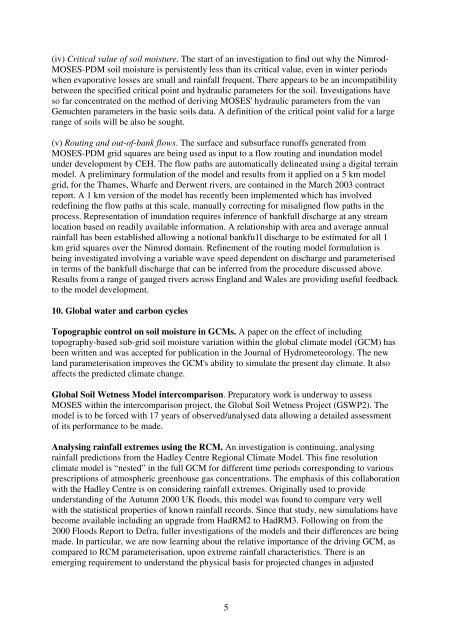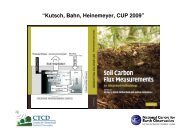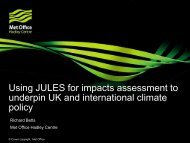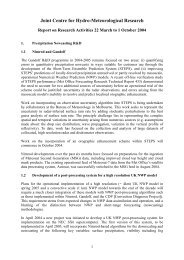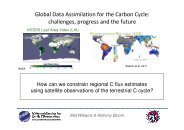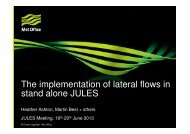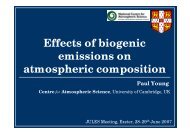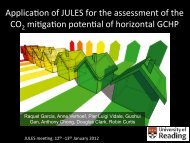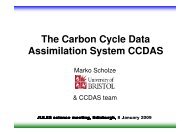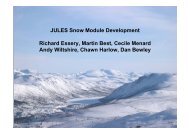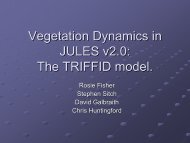here in PDF format - Joint Centre for Hydro-Meteorological Research
here in PDF format - Joint Centre for Hydro-Meteorological Research
here in PDF format - Joint Centre for Hydro-Meteorological Research
Create successful ePaper yourself
Turn your PDF publications into a flip-book with our unique Google optimized e-Paper software.
(iv) Critical value of soil moisture. The start of an <strong>in</strong>vestigation to f<strong>in</strong>d out why the Nimrod-<br />
MOSES-PDM soil moisture is persistently less than its critical value, even <strong>in</strong> w<strong>in</strong>ter periods<br />
when evaporative losses are small and ra<strong>in</strong>fall frequent. T<strong>here</strong> appears to be an <strong>in</strong>compatibility<br />
between the specified critical po<strong>in</strong>t and hydraulic parameters <strong>for</strong> the soil. Investigations have<br />
so far concentrated on the method of deriv<strong>in</strong>g MOSES' hydraulic parameters from the van<br />
Genuchten parameters <strong>in</strong> the basic soils data. A def<strong>in</strong>ition of the critical po<strong>in</strong>t valid <strong>for</strong> a large<br />
range of soils will be also be sought.<br />
(v) Rout<strong>in</strong>g and out-of-bank flows. The surface and subsurface runoffs generated from<br />
MOSES-PDM grid squares are be<strong>in</strong>g used as <strong>in</strong>put to a flow rout<strong>in</strong>g and <strong>in</strong>undation model<br />
under development by CEH. The flow paths are automatically del<strong>in</strong>eated us<strong>in</strong>g a digital terra<strong>in</strong><br />
model. A prelim<strong>in</strong>ary <strong>for</strong>mulation of the model and results from it applied on a 5 km model<br />
grid, <strong>for</strong> the Thames, Wharfe and Derwent rivers, are conta<strong>in</strong>ed <strong>in</strong> the March 2003 contract<br />
report. A 1 km version of the model has recently been implemented which has <strong>in</strong>volved<br />
redef<strong>in</strong><strong>in</strong>g the flow paths at this scale, manually correct<strong>in</strong>g <strong>for</strong> misaligned flow paths <strong>in</strong> the<br />
process. Representation of <strong>in</strong>undation requires <strong>in</strong>ference of bankfull discharge at any stream<br />
location based on readily available <strong>in</strong><strong><strong>for</strong>mat</strong>ion. A relationship with area and average annual<br />
ra<strong>in</strong>fall has been established allow<strong>in</strong>g a notional bankfu1l discharge to be estimated <strong>for</strong> all 1<br />
km grid squares over the Nimrod doma<strong>in</strong>. Ref<strong>in</strong>ement of the rout<strong>in</strong>g model <strong>for</strong>mulation is<br />
be<strong>in</strong>g <strong>in</strong>vestigated <strong>in</strong>volv<strong>in</strong>g a variable wave speed dependent on discharge and parameterised<br />
<strong>in</strong> terms of the bankfull discharge that can be <strong>in</strong>ferred from the procedure discussed above.<br />
Results from a range of gauged rivers across England and Wales are provid<strong>in</strong>g useful feedback<br />
to the model development.<br />
10. Global water and carbon cycles<br />
Topographic control on soil moisture <strong>in</strong> GCMs. A paper on the effect of <strong>in</strong>clud<strong>in</strong>g<br />
topography-based sub-grid soil moisture variation with<strong>in</strong> the global climate model (GCM) has<br />
been written and was accepted <strong>for</strong> publication <strong>in</strong> the Journal of <strong>Hydro</strong>meteorology. The new<br />
land parameterisation improves the GCM's ability to simulate the present day climate. It also<br />
affects the predicted climate change.<br />
Global Soil Wetness Model <strong>in</strong>tercomparison. Preparatory work is underway to assess<br />
MOSES with<strong>in</strong> the <strong>in</strong>tercomparison project, the Global Soil Wetness Project (GSWP2). The<br />
model is to be <strong>for</strong>ced with 17 years of observed/analysed data allow<strong>in</strong>g a detailed assessment<br />
of its per<strong>for</strong>mance to be made.<br />
Analys<strong>in</strong>g ra<strong>in</strong>fall extremes us<strong>in</strong>g the RCM. An <strong>in</strong>vestigation is cont<strong>in</strong>u<strong>in</strong>g, analys<strong>in</strong>g<br />
ra<strong>in</strong>fall predictions from the Hadley <strong>Centre</strong> Regional Climate Model. This f<strong>in</strong>e resolution<br />
climate model is “nested” <strong>in</strong> the full GCM <strong>for</strong> different time periods correspond<strong>in</strong>g to various<br />
prescriptions of atmospheric greenhouse gas concentrations. The emphasis of this collaboration<br />
with the Hadley <strong>Centre</strong> is on consider<strong>in</strong>g ra<strong>in</strong>fall extremes. Orig<strong>in</strong>ally used to provide<br />
understand<strong>in</strong>g of the Autumn 2000 UK floods, this model was found to compare very well<br />
with the statistical properties of known ra<strong>in</strong>fall records. S<strong>in</strong>ce that study, new simulations have<br />
become available <strong>in</strong>clud<strong>in</strong>g an upgrade from HadRM2 to HadRM3. Follow<strong>in</strong>g on from the<br />
2000 Floods Report to Defra, fuller <strong>in</strong>vestigations of the models and their differences are be<strong>in</strong>g<br />
made. In particular, we are now learn<strong>in</strong>g about the relative importance of the driv<strong>in</strong>g GCM, as<br />
compared to RCM parameterisation, upon extreme ra<strong>in</strong>fall characteristics. T<strong>here</strong> is an<br />
emerg<strong>in</strong>g requirement to understand the physical basis <strong>for</strong> projected changes <strong>in</strong> adjusted<br />
5


